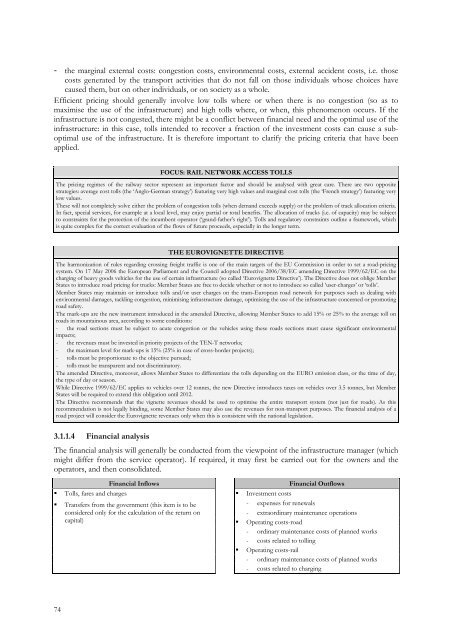Guide to COST-BENEFIT ANALYSIS of investment projects - Ramiri
Guide to COST-BENEFIT ANALYSIS of investment projects - Ramiri
Guide to COST-BENEFIT ANALYSIS of investment projects - Ramiri
You also want an ePaper? Increase the reach of your titles
YUMPU automatically turns print PDFs into web optimized ePapers that Google loves.
- the marginal external costs: congestion costs, environmental costs, external accident costs, i.e. thosecosts generated by the transport activities that do not fall on those individuals whose choices havecaused them, but on other individuals, or on society as a whole.Efficient pricing should generally involve low <strong>to</strong>lls where or when there is no congestion (so as <strong>to</strong>maximise the use <strong>of</strong> the infrastructure) and high <strong>to</strong>lls where, or when, this phenomenon occurs. If theinfrastructure is not congested, there might be a conflict between financial need and the optimal use <strong>of</strong> theinfrastructure: in this case, <strong>to</strong>lls intended <strong>to</strong> recover a fraction <strong>of</strong> the <strong>investment</strong> costs can cause a suboptimaluse <strong>of</strong> the infrastructure. It is therefore important <strong>to</strong> clarify the pricing criteria that have beenapplied.FOCUS: RAIL NETWORK ACCESS TOLLSThe pricing regimes <strong>of</strong> the railway sec<strong>to</strong>r represent an important fac<strong>to</strong>r and should be analysed with great care. There are two oppositestrategies: average cost <strong>to</strong>lls (the ‘Anglo-German strategy’) featuring very high values and marginal cost <strong>to</strong>lls (the ‘French strategy’) featuring verylow values.These will not completely solve either the problem <strong>of</strong> congestion <strong>to</strong>lls (when demand exceeds supply) or the problem <strong>of</strong> track allocation criteria.In fact, special services, for example at a local level, may enjoy partial or <strong>to</strong>tal benefits. The allocation <strong>of</strong> tracks (i.e. <strong>of</strong> capacity) may be subject<strong>to</strong> constraints for the protection <strong>of</strong> the incumbent opera<strong>to</strong>r (‘grand-father’s right’). Tolls and regula<strong>to</strong>ry constraints outline a framework, whichis quite complex for the correct evaluation <strong>of</strong> the flows <strong>of</strong> future proceeds, especially in the longer term.THE EUROVIGNETTE DIRECTIVEThe harmonization <strong>of</strong> rules regarding crossing freight traffic is one <strong>of</strong> the main targets <strong>of</strong> the EU Commission in order <strong>to</strong> set a road-pricingsystem. On 17 May 2006 the European Parliament and the Council adopted Directive 2006/38/EC amending Directive 1999/62/EC on thecharging <strong>of</strong> heavy goods vehicles for the use <strong>of</strong> certain infrastructure (so called ‘Eurovignette Directive’). The Directive does not oblige MemberStates <strong>to</strong> introduce road pricing for trucks: Member States are free <strong>to</strong> decide whether or not <strong>to</strong> introduce so called ‘user-charges’ or ‘<strong>to</strong>lls’.Member States may maintain or introduce <strong>to</strong>lls and/or user charges on the trans-European road network for purposes such as dealing withenvironmental damages, tackling congestion, minimising infrastructure damage, optimising the use <strong>of</strong> the infrastructure concerned or promotingroad safety.The mark-ups are the new instrument introduced in the amended Directive, allowing Member States <strong>to</strong> add 15% or 25% <strong>to</strong> the average <strong>to</strong>ll onroads in mountainous area, according <strong>to</strong> some conditions:- the road sections must be subject <strong>to</strong> acute congestion or the vehicles using these roads sections must cause significant environmentalimpacts;- the revenues must be invested in priority <strong>projects</strong> <strong>of</strong> the TEN-T networks;- the maximum level for mark-ups is 15% (25% in case <strong>of</strong> cross-border <strong>projects</strong>);- <strong>to</strong>lls must be proportionate <strong>to</strong> the objective pursued;- <strong>to</strong>lls must be transparent and not discrimina<strong>to</strong>ry.The amended Directive, moreover, allows Member States <strong>to</strong> differentiate the <strong>to</strong>lls depending on the EURO emission class, or the time <strong>of</strong> day,the type <strong>of</strong> day or season.While Directive 1999/62/EC applies <strong>to</strong> vehicles over 12 <strong>to</strong>nnes, the new Directive introduces taxes on vehicles over 3.5 <strong>to</strong>nnes, but MemberStates will be required <strong>to</strong> extend this obligation until 2012.The Directive recommends that the vignette revenues should be used <strong>to</strong> optimise the entire transport system (not just for roads). As thisrecommendation is not legally binding, some Member States may also use the revenues for non-transport purposes. The financial analysis <strong>of</strong> aroad project will consider the Eurovignette revenues only when this is consistent with the national legislation.3.1.1.4 Financial analysisThe financial analysis will generally be conducted from the viewpoint <strong>of</strong> the infrastructure manager (whichmight differ from the service opera<strong>to</strong>r). If required, it may first be carried out for the owners and theopera<strong>to</strong>rs, and then consolidated.Financial InflowsFinancial Outflows• Tolls, fares and charges • Investment costs• Transfers from the government (this item is <strong>to</strong> be- expenses for renewalsconsidered only for the calculation <strong>of</strong> the return on- extraordinary maintenance operationscapital) • Operating costs-road- ordinary maintenance costs <strong>of</strong> planned works- costs related <strong>to</strong> <strong>to</strong>lling• Operating costs-rail- ordinary maintenance costs <strong>of</strong> planned works- costs related <strong>to</strong> charging74




